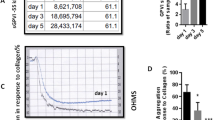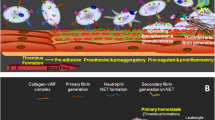Abstract
Thrombosis involves different stages including platelet adhesion to the site of injury, aggregatory events governed by integrin activation, pro-inflammatory responses recruiting leukocytes and finally, pro-coagulant activity which results in fibrin generation and clot formation. As important signaling agents, reactive oxygen species (ROS) reduce thrombus volume and growth, however given such a multistage mechanism, it is not well-elucidated how ROS inhibition modulates thrombosis. PRP-platelet concentrates (PCs) were either treated with ROS-reducing agents (1 mM NAC or 30 μM NOX inhibitor, VAS2870) or kept untreated during storage. Shedding and expression of platelet adhesion receptors in presence of inhibitors, agonists and CCCP (as controls) were analyzed by flow cytometery and western blot respectively. Besides above parameters, platelet adhesion to collagen in stored platelets was examined in presence of ROS inhibitors using fluorescence-microscopy. Highest levels of adhesion receptors shedding were achieved by ionophore and CCCP while collagen induces much more GPVI shedding than that of GPIbα. ROS inhibition reduced receptors shedding from day 3 of storage while enhanced their expressions. ROS inhibition not only did not reduce platelet adhesion capacity but it also enhanced platelets adhesion (in presence of NAC) or spreading (in presence of VAS2870) in 5 days-stored PCs. While reducing state significantly inhibits platelet aggregation and thrombus growth, our results indicated that as a first stage of thrombosis, platelet adhesion is resistance to such inhibitory effects. These findings highlight the fact that integrin-dependent platelet activation is much more vulnerable to the inhibition of ROS generation than GPVI-dependent platelet adhesion. Presumably, inhibition of platelet activating signals by ROS inhibitors preserves platelet adhesiveness to collagen due to lessening GPVI shedding.





Similar content being viewed by others
Abbreviations
- ADAM:
-
A disintegrin and metalloproteinase
- CaM:
-
Calmodulin
- Ca2 +:
-
Calcium
- Cys-residue:
-
Cysteine residue
- DAG:
-
Diacylglycerol
- DTS:
-
Dense tubular system
- FcRγ:
-
Fc receptor gamma
- GPIbα:
-
Glycoprotein Ibα
- GPV:
-
Glycoprotein V
- GPVI:
-
Glycoprotein VI
- IP3:
-
Inositol triphosphate
- ITAM:
-
Immunoreceptor Tyrosine-based Activation Motif
- NAC:
-
N-acetylcysteine
- NOX:
-
NADPH oxidase
- PC:
-
Platelet concentrate
- PI3K:
-
Phosphatidylinositol 3-kinase
- PIP2:
-
Phosphatidylinositol 4, 5-bisphosphate
- PKC:
-
Protein kinases C
- PLCγ2:
-
Phospholipase C gamma 2
- PTP:
-
Protein tyrosine phosphatase
- P38-MAPK:
-
P38-mitogen-activated protein kinase
- P47phox:
-
P47 phagocyte oxidase
- ROS:
-
Reactive Oxygen Species
- SFK:
-
Sarcoma family kinase
- SyK:
-
Spleen tyrosine kinase
- TRAF:
-
Tumor necrosis factor receptor associated factor
References
Ghasemzadeh M, Hosseini E, Ghasabeh AS, Hosseini KM (2018) Reactive Oxygen Species Generated by CD45-Cells Distinct from Leukocyte Population in Platelet Concentrates Is Correlated with the Expression and Release of Platelet Activation Markers during Storage. Transfusion Medicine and Hemotherapy 45:33–41
Rinalducci S, Zolla L (2015) Biochemistry of storage lesions of red cell and platelet concentrates: A continuous fight implying oxidative/nitrosative/phosphorylative stress and signaling. Transfus Apheres Sci 52:262–269
Arthur JF, Gardiner EE, Kenny D, Andrews RK, Berndt MC (2008) Platelet receptor redox regulation. Platelets 19:1–8
Violi F, Pignatelli P (2014) Platelet NOX, a novel target for anti-thrombotic treatment. Thromb Haemost 112:817–823
Begonja AJ, Gambaryan S, Geiger J, Aktas B, Pozgajova M, Nieswandt B, Walter U (2005) Platelet NAD (P) H-oxidase–generated ROS production regulates αIIbβ3-integrin activation independent of the NO/cGMP pathway. Blood 106:2757–2760
Walsh T, Berndt M, Carrim N, Cowman J, Kenny D, Metharom P (2014) The role of Nox1 and Nox2 in GPVI-dependent platelet activation and thrombus formation. Redox biology 2:178–186
Hosseini E, Mohtashami M, Ghasemzadeh M (2019) Down-regulation of platelet adhesion receptors is a controlling mechanism of thrombosis, while also affecting post-transfusion efficacy of stored platelets. Thrombosis journal 17:1–11
Qiao J, Arthur JF, Gardiner EE, Andrews RK, Zeng L, Xu K (2018) Regulation of platelet activation and thrombus formation by reactive oxygen species. Redox biology 14:126–130
Hartmann M, Herrlich A, Herrlich P (2013) Who decides when to cleave an ectodomain? Trends Biochem Sci 38:111–120
Ray PD, Huang B-W, Tsuji Y (2012) Reactive oxygen species (ROS) homeostasis and redox regulation in cellular signaling. Cell Signal 24:981–990
Yamamori T, Inanami O, Nagahata H, Cui Y-D, Kuwabara M (2000) Roles of p38 MAPK, PKC and PI3-K in the signaling pathways of NADPH oxidase activation and phagocytosis in bovine polymorphonuclear leukocytes. FEBS Lett 467:253–258
Brill A, Chauhan AK, Canault M, Walsh MT, Bergmeier W, Wagner DD (2009) Oxidative stress activates ADAM17/TACE and induces its target receptor shedding in platelets in a p38-dependent fashion. Cardiovasc Res 84:137–144
Ghasemzadeh M, Hosseini E, Roudsari ZO, Zadkhak P (2018) Intraplatelet reactive oxygen species (ROS) correlate with the shedding of adhesive receptors, microvesiculation and platelet adhesion to collagen during storage: Does endogenous ROS generation downregulate platelet adhesive function? Thromb Res 163:153–161
Zhang P, Du J, Zhao L, Wang X, Zhang Y, Yan R, Dai J, Liu G, Zhang F, Dai K (2013) The role of intraplatelet reactive oxygen species in the regulation of platelet glycoprotein Ibα ectodomain shedding. Thromb Res 132:696–701
Aubron C, Flint AW, Ozier Y, McQuilten Z (2018) Platelet storage duration and its clinical and transfusion outcomes: a systematic review. Crit Care 22:185
Chen W, Liang X, Syed AK, Jessup P, Church WR, Ware J, Josephson CD, Li R (2016) Inhibiting GPIbα shedding preserves post-transfusion recovery and hemostatic function of platelets after prolonged storage. Arterioscler Thromb Vasc Biol 36:1821–1828
Kulkarni S, Woollard KJ, Thomas S, Oxley D, Jackson SP (2007) Conversion of platelets from a proaggregatory to a proinflammatory adhesive phenotype: role of PAF in spatially regulating neutrophil adhesion and spreading. Blood 110:1879–1886
Fu Q, Garnham CP, Elliott ST, Bovenkamp DE, Van Eyk JE (2005) A robust, streamlined, and reproducible method for proteomic analysis of serum by delipidation, albumin and IgG depletion, and two-dimensional gel electrophoresis. Proteomics 5:2656–2664
Hosseini E, Ghasemzadeh M, Nassaji F, Jamaat ZP (2017) GPVI modulation during platelet activation and storage: its expression levels and ectodomain shedding compared to markers of platelet storage lesion. Platelets 28:498–508
Bender M, Hofmann S, Stegner D, Chalaris A, Bosl M, Braun A, Scheller J, Rose-John S, Nieswandt B (2010) Differentially regulated GPVI ectodomain shedding by multiple platelet-expressed proteinases. Blood 116:3347–3355
Hosseini E, Ghasemzadeh M, Atashibarg M, Haghshenas M (2019) ROS scavenger, N-acetyl-l-cysteine and NOX specific inhibitor, VAS2870 reduce platelets apoptosis while enhancing their viability during storage. Transfusion 59:1333–1343
Jang JY, Min JH, Chae YH, Baek JY, Wang SB, Park SJ, Oh GT, Lee S-H, Ho Y-S, Chang T-S (2014) Reactive oxygen species play a critical role in collagen-induced platelet activation via SHP-2 oxidation. Antioxid Redox Signal 20:2528–2540
Andrews RK, Karunakaran D, Gardiner EE, Berndt MC (2007) Platelet receptor proteolysis: a mechanism for downregulating platelet reactivity. Arterioscler Thromb Vasc Biol 27:1511–1520
Hosseini E, Beshkar P, Ghasemzadeh M (2018) Reverse correlations of collagen-dependent platelet aggregation and adhesion with GPVI shedding during storage. J Thromb Thrombolysis 46:534–540
Johnson L, Cameron M, Waters L, Padula MP, Marks DC (2019) The impact of refrigerated storage of UVC pathogen inactivated platelet concentrates on in vitro platelet quality parameters. Vox Sang 114:47–56
Krötz F, Sohn H-Y, Pohl U (2004) Reactive oxygen species: players in the platelet game. Arterioscler Thromb Vasc Biol 24:1988–1996
Violi F, Pignatelli P (2012) Platelet oxidative stress and thrombosis. Thromb Res 129:378–381
Gardiner EE, Karunakaran D, Shen Y, Arthur JF, Andrews RK, Berndt MC (2007) Controlled shedding of platelet glycoprotein (GP) VI and GPIb–IX–V by ADAM family metalloproteinases. J Thromb Haemost 5:1530–1537
Andersen H, Greenberg DL, Fujikawa K, Xu W, Chung DW, Davie EW (1999) Protease-activated receptor 1 is the primary mediator of thrombin-stimulated platelet procoagulant activity. Proc Natl Acad Sci 96:11189–11193
M. Ghasemzadeh. Investigation of signaling cross-talk between platelets and neutrophils. Monash University. Faculty of Medicine, Nursing and Health Sciences. Australian Centre for Blood Diseases; 2009.
**ao B, Goh J-Y, **ao L, **an H, Lim K-L, Liou Y-C (2017) Reactive oxygen species trigger Parkin/PINK1 pathway–dependent mitophagy by inducing mitochondrial recruitment of Parkin. J Biol Chem 292:16697–16708
Matsushima S, Tsutsui H, Sadoshima J (2014) Physiological and pathological functions of NADPH oxidases during myocardial ischemia–reperfusion. Trends Cardiovasc Med 24:202–205
Pignatelli P, Carnevale R, Di Santo S, Bartimoccia S, Sanguigni V, Lenti L, Finocchi A, Mendolicchio L, Soresina AR, Plebani A (2011) Inherited human gp91phox deficiency is associated with impaired isoprostane formation and platelet dysfunction. Arterioscler Thromb Vasc Biol 31:423–434
Sonkar VK, Kumar R, Jensen M, Wagner BA, Sharathkumar AA, Miller FJ Jr, Fasano M, Lentz SR, Buettner GR, Dayal S (2019) Nox2 NADPH oxidase is dispensable for platelet activation or arterial thrombosis in mice. Blood advances 3:1272–1284
Acknowledegment
This work was part of Dr. Ghasemzadeh’s approved projects (No.1394-01-33-1862 and No.1396-06-33-2099) supported by High Institute for Research and Education in Transfusion Medicine. Parts of this work were presented as thesis programs for Master students Zahra roudsari and Amin Soluki. The authors declare no conflict of interests.
Author information
Authors and Affiliations
Contributions
MG provided conceptual input, supervised and designed the study, did the experiments, analyzed the data and wrote the paper. EH, provided conceptual input, co-supervised the study, did the experiments and co-wrote the paper. AS did some experiments and helped with paper preparation. ZR did some experiments. FK critically reviewed the paper.
Corresponding author
Ethics declarations
Conflict of interest
The authors declare no conflict of interests.
Additional information
Publisher's Note
Springer Nature remains neutral with regard to jurisdictional claims in published maps and institutional affiliations.
Rights and permissions
About this article
Cite this article
Hosseini, E., Solouki, A., Roudsari, Z.O. et al. Reducing state attenuates ectodomain shedding of GPVI while restoring adhesion capacities of stored platelets: evidence addressing the controversy around the effects of redox condition on thrombosis. J Thromb Thrombolysis 50, 123–134 (2020). https://doi.org/10.1007/s11239-020-02137-0
Published:
Issue Date:
DOI: https://doi.org/10.1007/s11239-020-02137-0




